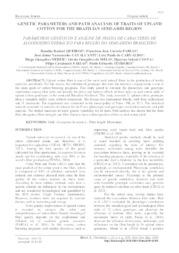Genetic parameters and path analysis of traits of upland cotton for the brazilian Semi-Arid region.
Genetic parameters and path analysis of traits of upland cotton for the brazilian Semi-Arid region.
Author(s): QUEIROZ, D. R.; FARIAS, F. J. C.; CAVALCANTI, J. J. V.; CARVALHO, L. P. de; NEDER, D. G.; MELO, G. G. de; COSTA, D. S.; FARIAS, F. C.; TEODORO, P. E.
Summary: Upland cotton fiber is one of the most used natural fibers in the production of textile materials worldwide. For this reason, the selection of genotypes that meet the industry?s requirements is one of the main goals of cotton breeding programs. This study aimed to estimate the phenotypic and genotypic correlations among fiber traits and identify the direct and indirect effects of these traits on seed cotton yield of upland cotton genotypes in the semi-arid Brazilian Northeast. This study assessed 21 upland cotton genotypes from a complete diallel cross without reciprocals. The design was randomized blocks, with three replications and 21 treatments. The experiment was conducted in the municipality of Patos - PB, in 2015. The statistical analysis consisted of analysis of variance by the F test, phenotypic and genotypic correlation analysis, and path analysis. The studied materials revealed genetic variability for all traits. Path analysis has shown that the traits fiber elongation, fiber strength, and fiber fineness have a direct positive effect on seed cotton yield.
Publication year: 2019
Types of publication: Journal article
Unit: Embrapa Cotton
Keywords: Algodão, Cotton, Fiber length, Fiber quality, Gossypium Hirsutum, Micronaire, Yields
Observation
Some of Embrapa's publications are published as ePub files. To read them, use or download one of the following free software options to your computer or mobile device. Android: Google Play Books; IOS: iBooks; Windows and Linux: Calibre.
Access other publications
Access the Agricultural Research Database (BDPA) to consult Embrapa's full library collection and records.
Visit Embrapa Bookstore to purchase books and other publications sold by Embrapa.

